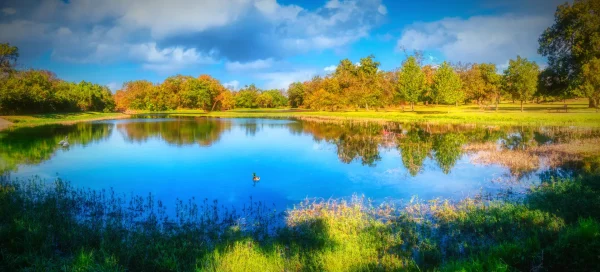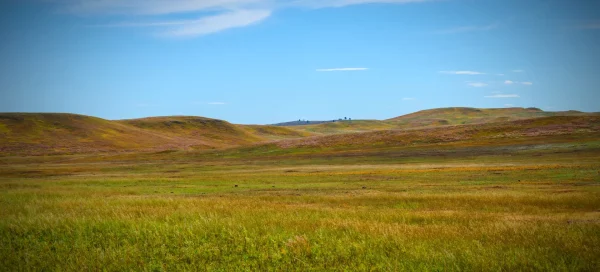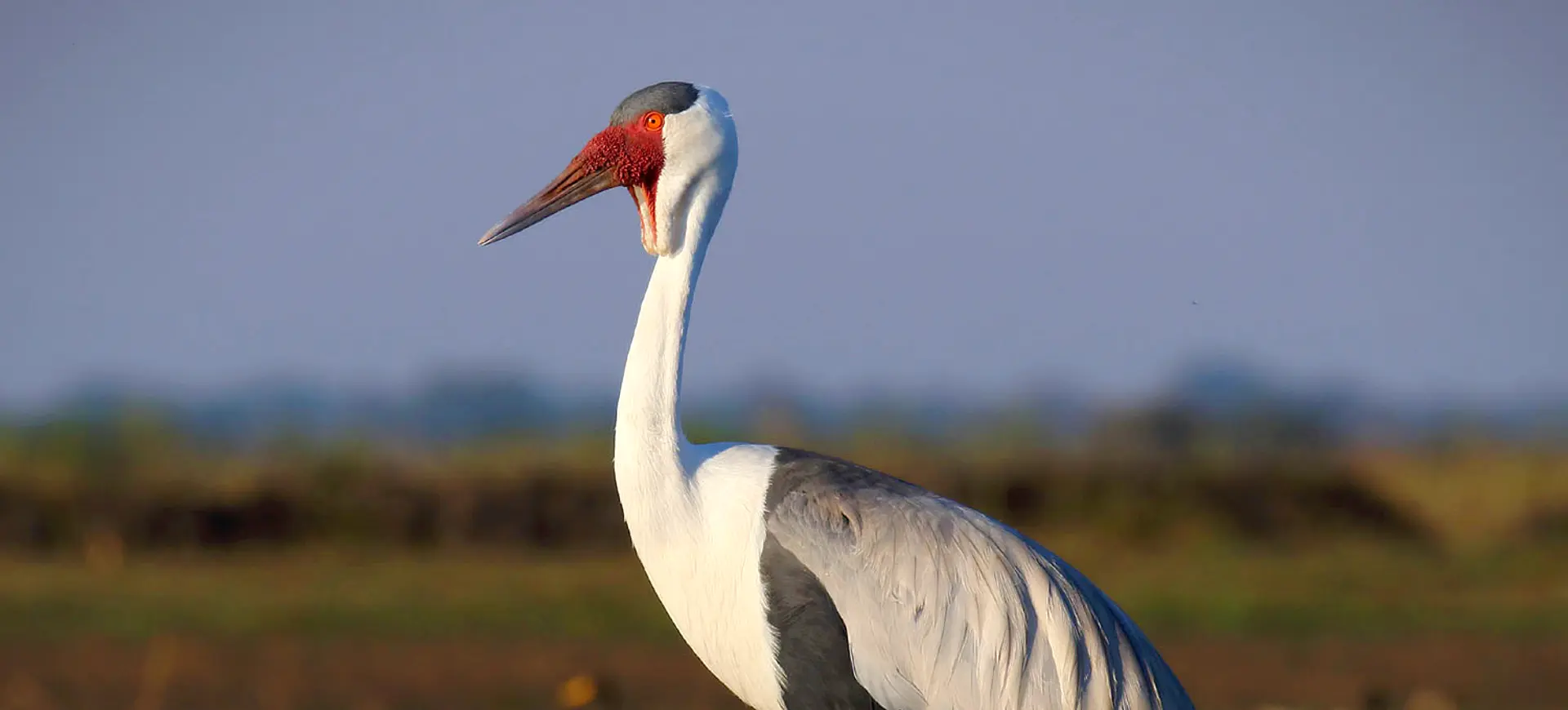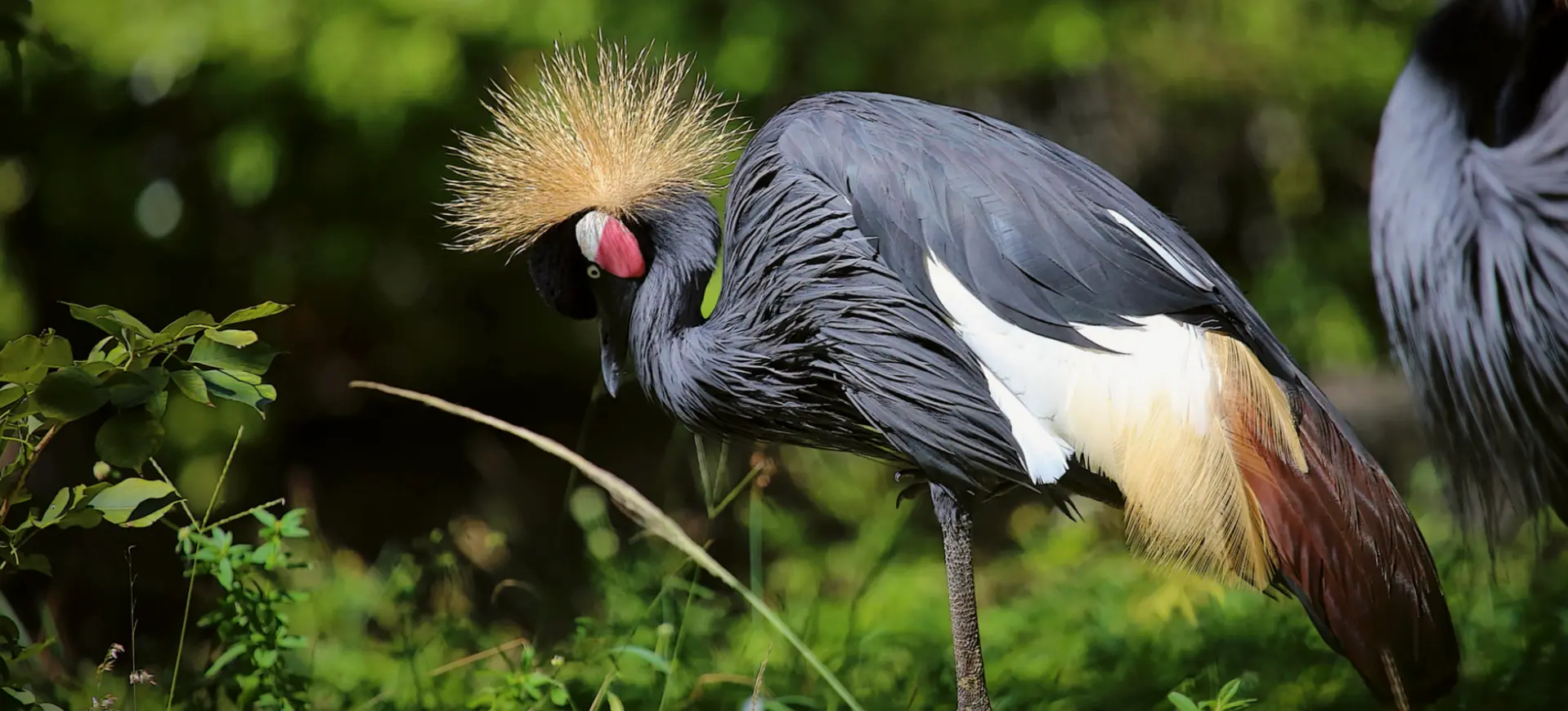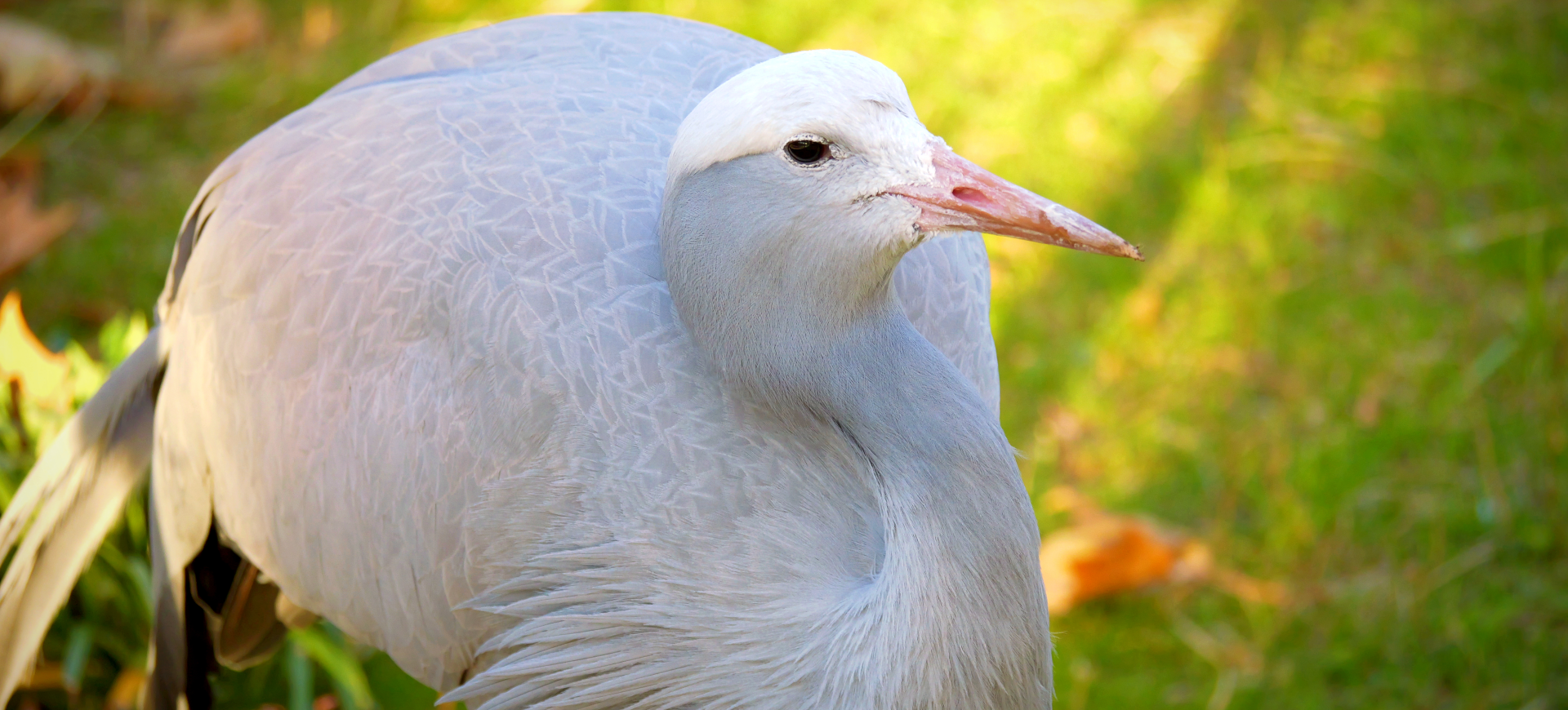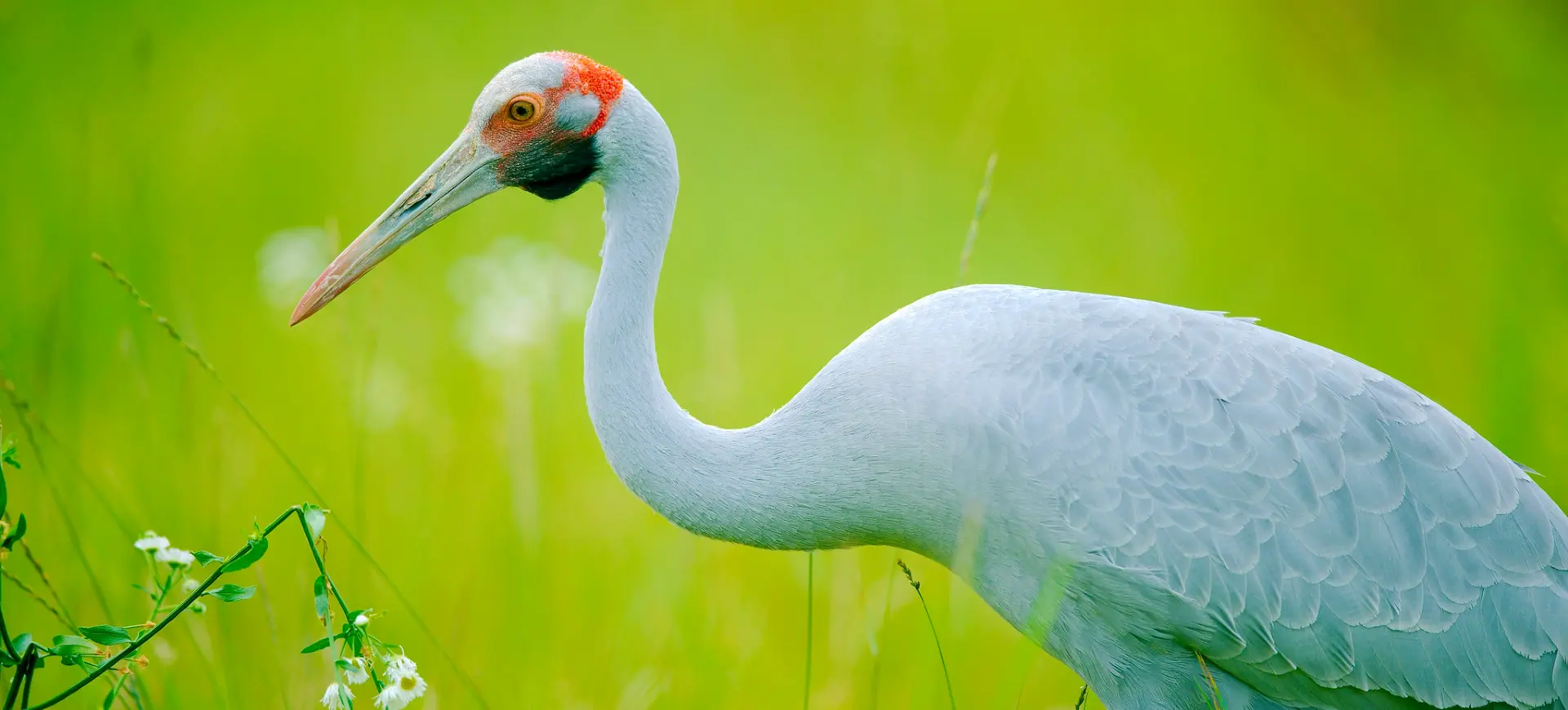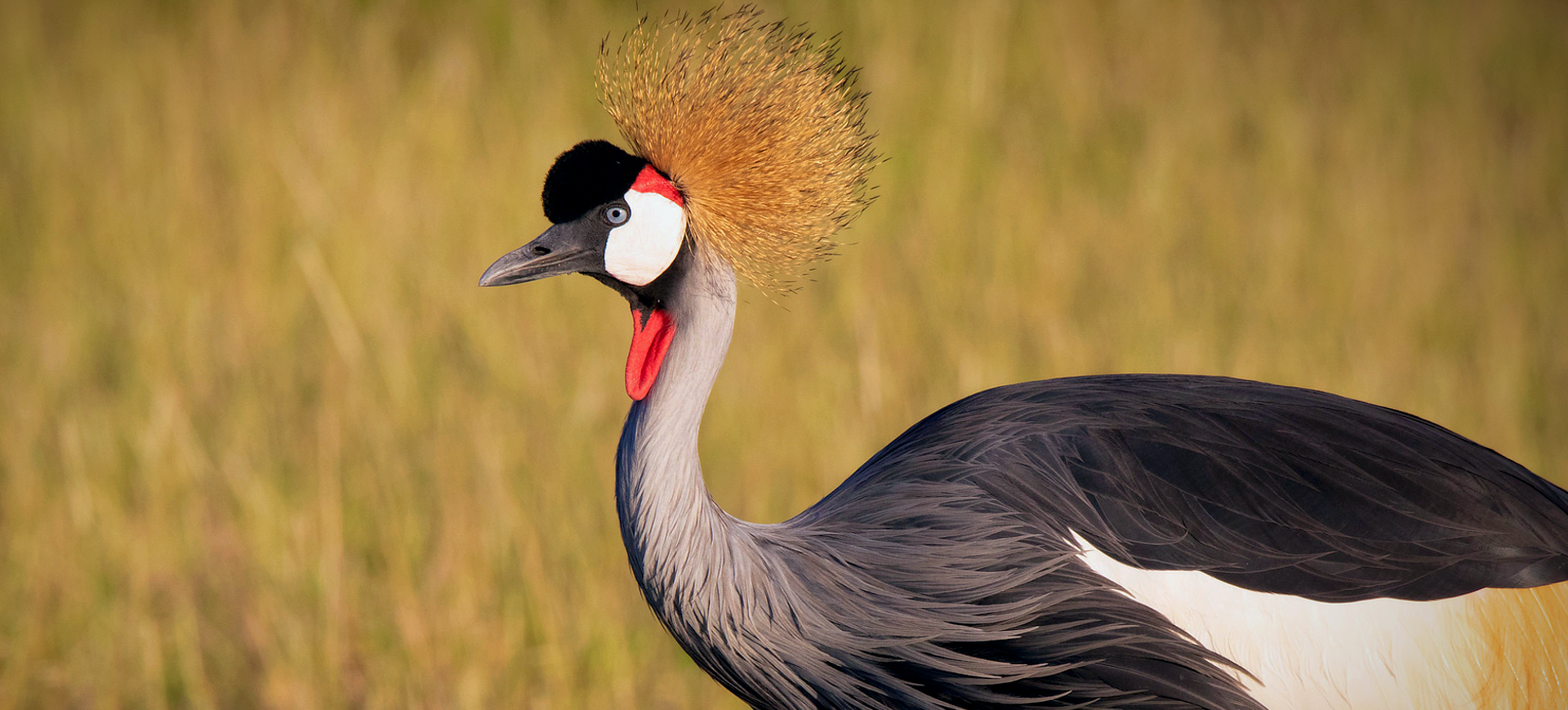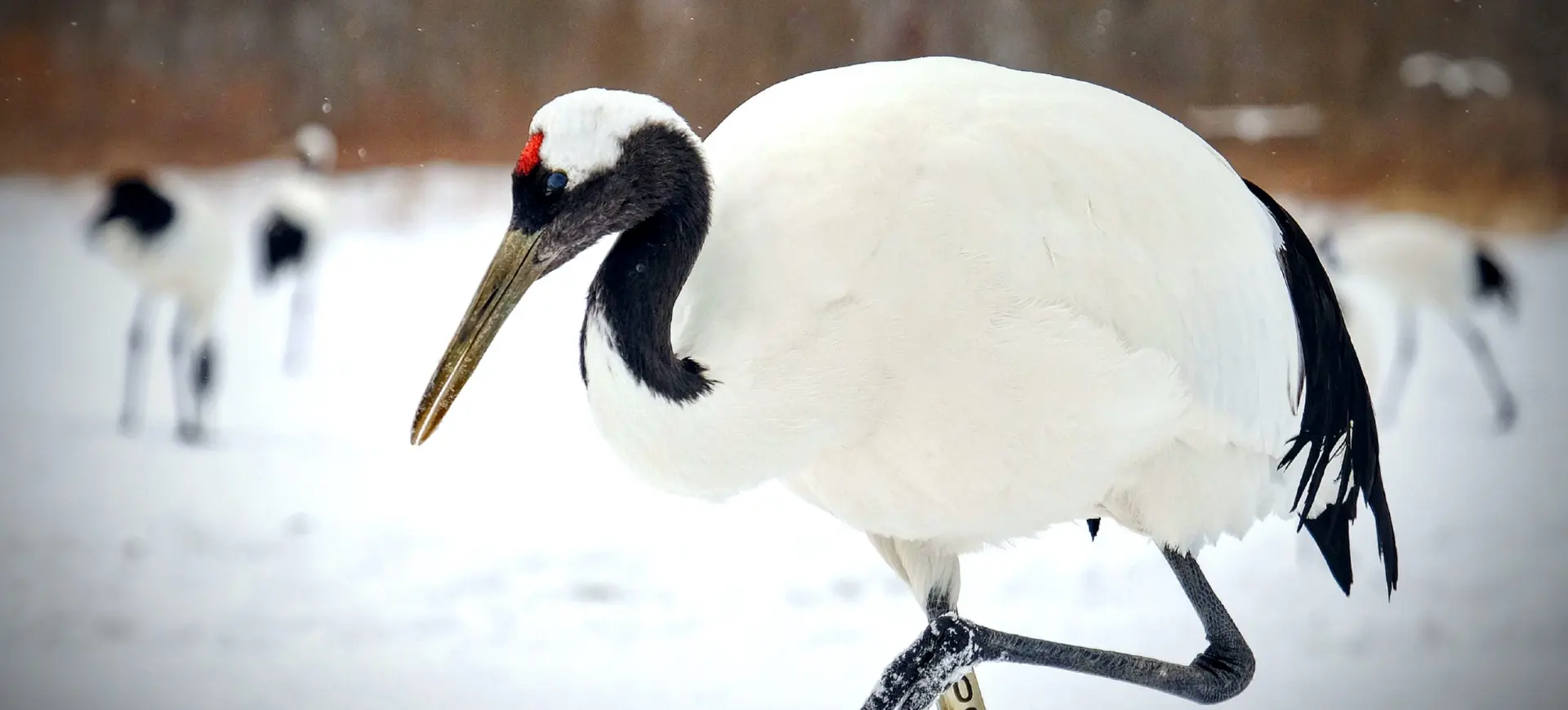Overview
The Sarus Crane is the tallest flying bird in the world, standing out due to its striking red head and upper neck contrasted against its grey body. It is a non-migratory species that primarily inhabits wetlands, grasslands, and agricultural fields across South Asia, Southeast Asia, and Australia. Known for its elaborate courtship displays, the Sarus Crane symbolizes fidelity and long-term pair bonding. Despite its adaptability, the species is facing population decline due to habitat loss, agricultural expansion, and pollution.
Sarus Cranes are highly social, often seen in pairs or small family groups, but may gather in larger numbers outside the breeding season. They are known for their loud, trumpeting calls, which can be heard over long distances and play a crucial role in communication. Unlike many other crane species, Sarus Cranes do not undertake long migrations but may move locally in search of suitable foraging grounds. Conservationists are concerned about their future as their wetland habitats are drained or converted for agricultural use.
These cranes have various food preferences, making them omnivorous feeders that can adapt to different environments. They are often found near human settlements, especially in regions where traditional rice paddies provide a mix of foraging and nesting opportunities. The species’ cultural significance in many regions, especially India, has helped promote awareness about their conservation. However, increased efforts are needed to ensure that they remain a part of the ecosystems they have long inhabited.
Taxonomy
Kingdom
Phylum
Class
Order
Family
Genus
Species
Type
Current distribution:
The Sarus Crane has a wide but fragmented range, with populations across the Indian subcontinent, Southeast Asia, and northern Australia. The largest and most stable populations are found in India, particularly in the northern states of Uttar Pradesh and Rajasthan. Southeast Asian populations are more threatened, with significant declines reported in countries like Vietnam, Cambodia, and Thailand due to habitat loss. They are primarily found in northern regions of Australia, often sharing habitats with the closely related Brolga.
Local movements occur throughout their range, with some populations undertaking short-distance migrations or seasonal dispersal to find food. In India, they are a common sight in agricultural areas, where they have learned to coexist with human activities. The species' presence in multiple countries emphasizes the need for international conservation efforts to address threats across different habitats. Habitat fragmentation and changes in water availability continue to impact their distribution, necessitating strong, coordinated conservation measures.
Physical Description:
The Sarus Crane is distinguished by its tall stature, long neck, and primarily grey body with a vivid red head and upper neck. The red skin on the head and neck lacks feathers, while the bird’s long, greyish legs are adapted for wading through shallow water. The broad and powerful wings provide strong, steady flight, although they prefer walking and wading to flying. Adults have a white, fluffy tuft at the tail base, seen during displays and courtship rituals.
The Sarus Crane’s bill is long, sharp, and slightly pointed, aiding in foraging for a variety of food items. The red coloration on the head and neck is brighter during the breeding season, indicating readiness for mating. Juveniles are generally brownish and lack the prominent red coloring of adults, acquiring the mature plumage as they age. The crane’s overall body structure, including its long legs and neck, enables it to navigate and feed efficiently in wetland habitats.

Lifespan: Wild: ~25 Years || Captivity: ~40 Years

Weight: Male & Female: 11-26 lbs (5-12 kg)

Length: Male & Female: 60-70 in (152-178 cm)

Height: Male & Female: 60-70 in (152-178 cm)

Wingspan: Male & Female: 90-110 in (230-280 cm)

Top Speed: 25 mph (40 km/h)
Characteristic:
Native Habitat:
The Sarus Crane primarily inhabits wetlands, including marshes, swamps, and floodplains, where shallow water provides excellent foraging grounds. They are also found in agricultural fields, especially rice paddies, which mimic wetland conditions and offer a reliable food source. In Southeast Asia and India, they may be found in dry, open fields during the non-breeding season, but they remain close to water sources. During the breeding season, they prefer undisturbed wetlands with dense vegetation, which provides cover for nesting.
These cranes depend highly on water availability, making them sensitive to seasonal changes and water management practices. They are adaptable and can survive in altered habitats, but they require a combination of wetlands and dry areas to meet their needs throughout the year. The fragmentation and drainage of wetland habitats pose significant threats to their populations. Protecting traditional wetlands and sustainable agricultural practices are key to their survival in their native habitats.
Biomes:
Biogeographical Realms:
Diet:
Diet & Feeding Habits:
Sarus Cranes are omnivorous, feeding on a mix of plant and animal matter, depending on what is available. Their diet includes grains, seeds, tubers, insects, small vertebrates, and aquatic plants. They are often seen foraging in wetlands, where they probe the mud with their long bills to extract roots, insects, and small invertebrates. In agricultural areas, they frequently feed on crops like rice, maize, and wheat, which sometimes brings them into conflict with farmers.
These cranes use a variety of foraging strategies, including probing, pecking, and even turning over soil to find hidden food. They are opportunistic feeders, and their diet can vary widely with the seasons and availability of food resources. This adaptability has allowed them to thrive in different habitats, although it also means they are vulnerable to changes in land use and agricultural practices. In addition, their preference for shallow water habitats means that water management and wetland conservation are crucial for survival.
Mating Behavior:
Mating Description:
Sarus Cranes are monogamous, forming lifelong pair bonds reinforced through elaborate courtship displays. These displays include synchronized dancing, bowing, and unison calling, where pairs engage in rhythmic vocalizations. The pair bond is essential for breeding success, as both parents share responsibilities in nest building, incubation, and chick rearing. Nest sites are typically built in shallow water, using reeds and grasses to create a platform that floats on the surface.
The female usually lays two eggs, and both parents take turns incubating them for about a month. Chicks are precocial and can leave the nest within a day of hatching, although they depend on their parents for food and protection. Breeding success is heavily influenced by the availability of suitable, undisturbed nesting sites, which are increasingly threatened by human activity. The cranes return to the same nesting sites each year if favorable conditions remain.
Reproduction Season:
Birth Type:
Pregnancy Duration:
Female Name:
Male Name:
Baby Name:
Social Structure Description:
Sarus Cranes are known for their strong pair bonds, with monogamous pairs often staying together throughout their lives. Outside the breeding season, they may be seen in small family groups or loose flocks, especially in areas with abundant food. During the breeding season, they become territorial, and pairs isolate themselves to raise their young in peace. This social flexibility allows them to adapt to different environments, although it also means they are sensitive to disturbances near nesting sites.
Communication among Sarus Cranes includes a variety of vocalizations, displays, and synchronized movements. Their loud, trumpeting calls are used to communicate over long distances, reinforcing bonds between mates and signaling territory. Young cranes learn essential skills by staying with their parents for several months, including foraging and recognizing potential threats. The species’ social structure is integral to its survival, as cooperative behavior between mates ensures successful breeding and rearing of chicks.
Groups:
Conservation Status:
Population Trend:
The global population of Sarus Cranes has been declining, primarily due to habitat destruction and fragmentation. India hosts the largest population, where traditional farming practices have historically supported the species, but even here, numbers are dwindling in some regions. Southeast Asian populations are more critically endangered, with small, isolated groups struggling to survive due to wetland drainage and agricultural intensification. Australian populations are relatively stable but face habitat changes and human activity threats.
Efforts to protect and conserve Sarus Cranes are ongoing, focusing on wetland restoration, protection of nesting sites, and community engagement. International cooperation is necessary, particularly in Southeast Asia, where transboundary efforts can help maintain and restore important habitats. Captive breeding programs play a small but important role in ensuring genetic diversity, though reintroduction into the wild remains challenging. Population monitoring and research are key to understanding the specific needs and threats facing the species across its range.
Population Threats:
The primary threats to Sarus Cranes include habitat loss due to wetland drainage, conversion to agricultural land, and urbanization. Traditional wetland habitats have been drastically reduced in many parts of their range, leaving the cranes dependent on agricultural areas, where they are vulnerable to pesticides and disturbances. Climate change poses an additional threat by altering water availability, which affects their breeding and feeding grounds. Human encroachment and disturbance near nesting sites can lead to low breeding success, affecting population numbers.
Hunting and poaching have also been reported in Southeast Asia, although these activities are less common in India and Australia. Pollution, especially from agricultural runoff, degrades wetland habitats, impacting the availability of food and clean water. Conservation efforts are often hampered by a lack of resources, inconsistent enforcement of protected areas, and insufficient local community engagement. Protecting large, contiguous wetland areas is essential for the survival of these cranes, as fragmented habitats do not support stable breeding populations.
Conservation Efforts:
Numerous conservation projects have been initiated to protect the Sarus Crane, including habitat restoration, community engagement, and research. In India, traditional agricultural practices are being promoted to maintain crane-friendly environments, particularly in regions where they share habitats with farmers. International partnerships, such as the Wetlands International and the International Crane Foundation, are working to protect critical wetlands across the species’ range. Educational campaigns aim to raise awareness about the importance of wetland conservation for biodiversity, benefiting not only cranes but entire ecosystems.
Captive breeding and reintroduction programs are limited but continue to provide important insights into the species’ needs. Researchers are studying the effects of climate change on their habitats, which will be crucial for future conservation planning. Legal protections exist in several countries, but enforcing and effectively managing protected areas remains challenging. Collaborative efforts between governments, NGOs, and local communities are essential to address the complex issues that threaten the survival of the Sarus Crane.
Additional Resources:
Fun Facts
- The Sarus Crane is the tallest flying bird, reaching heights of up to six feet.
- They are famous for their elegant “dances,” which involve leaps, bows, and wing flapping.
- Unlike many other crane species, Sarus Cranes do not migrate long distances.
- They are often seen in pairs, symbolizing fidelity and long-term commitment.
- In India, the Sarus Crane is a cultural icon featured in folklore, poetry, and local traditions.
- Their name “Sarus” is derived from the Hindi word “sarhans,” meaning “lake bird.”
- Sarus Cranes can live up to 40 years in captivity, indicating their long lifespan potential.
- They can uniquely adapt to rice paddies, which mimic their natural wetland habitats.
- The Sarus Crane’s red head and neck are more vibrant during the breeding season, signaling mating readiness.
- They are one of the few crane species that are not migratory, though they may move locally in response to water availability.






